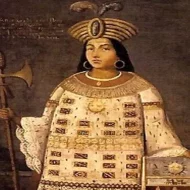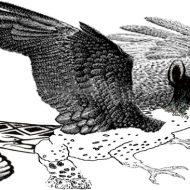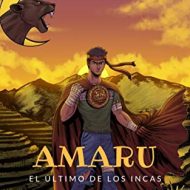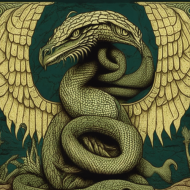Amaru : The Inca Dragon
Listen
At a glance
| Description | |
|---|---|
| Origin | Inca Mythology |
| Classification | Hybrids |
| Family Members | N/A |
| Region | Peru |
| Associated With | Travelling across dimensions |
Amaru
Introduction
Physical Traits
The Amaru is depicted variably in Inca mythology but consistently as a formidable creature, often portrayed as a massive serpent, sometimes with two heads symbolizing contrasting forces. Popular variations include heads resembling powerful animals such as a puma and a condor, reflecting its connection to diverse aspects of nature. Wings are occasionally added to its serpent form, suggesting its ability to move between earthly and spiritual realms. Bird-like talons or fish tails further emphasize its fantastical nature, underscoring its role as a mythical being of great significance. In Inca art, the Amaru is often adorned with feathers or crowns, emphasizing its divine nature and celestial associations. Its portrayal ranges from guardian to adversary, illustrating its complex role in Inca cosmology.
Family
The Amaru’s origins are veiled in mystery, though it is intertwined with the realm of the dead, Ukhu Pacha. Some legends suggest it could be the offspring of Viracocha, the supreme Inca deity, and Mama Qucha, the earth mother goddess, inheriting Viracocha’s creative force and Mama Qucha’s life-giving essence. Another perspective links the Amaru to the primordial goddess Catequil, who, in serpent form, predates all other deities and is credited with creating the world. This association underscores the Amaru’s deep connection to the origins of life and the powerful forces shaping the Inca cosmos. In Inca mythology, the Amaru is regarded as a significant progenitor deity, often associated with creation myths and the fundamental shaping of the natural world.
Other names
Throughout the Inca Empire, the Amaru was recognized by different names depending on regional influences. In areas influenced by Aymara culture, it was revered as Katari, highlighting a shared reverence for this serpent deity. Emphasizing specific attributes, it could also be referred to as “Cuchu Illa” (meaning “rainbow serpent”) or “Amaru Khan” (meaning “great serpent”). These variations underscore the diverse manifestations of the Amaru and its embodiment of various natural phenomena. In Quechua, the indigenous language of the Andean peoples, it is commonly known simply as Amaru or Amarú, translating to “serpent” or “snake.” Across mythological narratives of Andean cultures, the Amaru assumes different epithets or titles, each highlighting distinct facets of its character and significance within the divine order.
Powers and Abilities
Amaru, as a deity associated with serpents in Inca mythology, wields a diverse array of powers and abilities. It is believed to govern water sources such as rivers and lakes, influencing agricultural fertility and the prosperity of the land. Revered for its wisdom, Amaru serves as a guide to shamans and spiritual practitioners seeking insights into the natural order and existential mysteries. In mythological tales, Amaru demonstrates shape-shifting abilities, assuming various forms to interact with humans and other deities. Its capacity to move between the earthly realm and the celestial plane underscores its role as a mediator between humanity and the divine, offering protection and blessings to those who honor its sacred presence.
Deep within the earth, Amaru resides as a guardian of the Ukhu Pacha, the underworld, associated with seismic activities like earthquakes. Its movements were believed to cause the earth to tremble, symbolizing the immense power beneath the surface. Despite this association with destruction, Amaru’s connection to water sources positioned it as a vital symbol of life and fertility in Inca culture. Revered for safeguarding these life-giving resources, Amaru was seen as a protector of crops and a source of prosperity for the Incas.
In myths, Amaru is also depicted as a creative force, nurturing life within the earth and embodying both the destructive and life-giving aspects of nature. Beyond its physical prowess, Amaru symbolizes wisdom and knowledge, often depicted in the Yachay Wasikuna (Houses of Knowledge) as a testament to its importance in understanding the natural world and its intricate forces.
Amaru’s symbolism extends to its association with sudden environmental changes and its role as a bridge between the underworld and the celestial realms, exemplified through lightning and celestial phenomena. It remains a complex deity in Inca mythology, embodying a spectrum of attributes from protective guardian to harbinger of change and natural balance.
Modern Day Influence
Despite the decline of the Inca Empire and the encroachment of Western influence in South America, Amaru continues to be revered and its symbolism cherished among indigenous communities and spiritual practitioners. In contemporary Andean culture, festivals and rituals frequently incorporate Amaru as a symbol of fertility, abundance, and spiritual renewal. Its imagery transcends traditional folklore, inspiring contemporary artists, writers, and filmmakers exploring themes of myth, spirituality, and indigenous wisdom. As a guardian serpent, Amaru’s depiction captivates imaginations, bridging ancient traditions with modern interpretations across literature, visual arts, and cultural performances.
Beyond cultural influence, Amaru’s legacy persists in environmental conservation efforts throughout the Andean region. Many conservation organizations and local communities invoke Amaru’s spirit as a protector of natural resources, advocating for sustainable practices that honor the land’s sacred interconnectedness with the spiritual realm. In Peru, Bolivia, and other Andean regions, the serpent’s image remains a potent symbol in textiles, pottery, and modern architecture, reflecting its enduring significance. Amaru’s association with water underscores its ongoing relevance in environmental movements, emphasizing the critical importance of safeguarding water resources and respecting the delicate balance between humanity and nature.
In academic and cultural spheres alike, Amaru’s multifaceted mythology continues to intrigue researchers and enthusiasts. Whether depicted as a dual-headed serpent of the underworld or a winged creature engaged in mythical duels, Amaru prompts contemplation on the connections between South American and European dragon lore. It remains a vital figure in modern-day Inca culture, celebrated in artwork such as pottery, clothing, and jewelry, and revered as a deity by contemporary members of Andean communities and Quechua speakers.
Related Images
Frequently Asked Questions
Is Amaru a god?
The Inca’s Amaru wasn’t quite a god, but close. Immensely powerful, it symbolized nature’s wild forces – life from water, destruction from earthquakes. Revered, not supreme, the Amaru connected the physical world to the spiritual, a guardian deserving respect.
Who is Amaru in real life?
The name Amaru carries a fascinating duality in Inca history. It belonged to the last Inca emperor who fell to the Spanish conquest, and centuries later, his descendant who led a rebellion against Spanish rule used the same name as a symbol of resistance.
What is the origin of the name Amaru?
The name Amaru has a fascinating double origin in Inca history. In mythology, it likely stems from the Quechua word for “snake,” perfectly aligning with the serpent god imagery. For the Inca emperors, the source is less clear. It could be derived from Quechua with a different meaning, or possibly from Aymara, another Andean language, signifying concepts like “immortal” or “eternal.”
What is the spiritual meaning of Amaru?
What does Amaru represent?
The Amaru is believed to represent the creative power of humankind, Earth, and Mother Nature. It is also associated with the underworld and is seen as a symbol of the sudden and violent changes that can occur in the world.








